소개
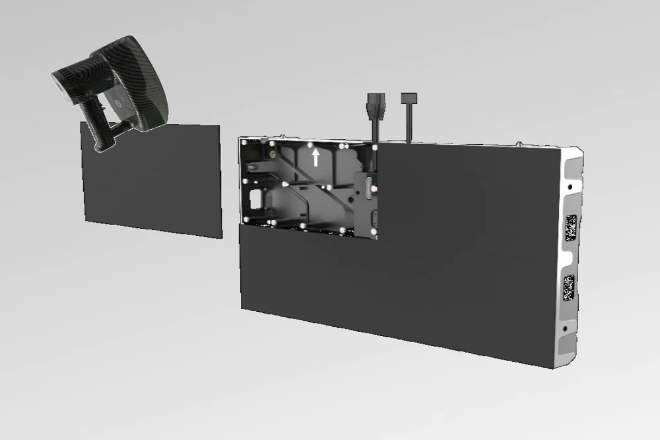
As an important carrier of information transmission, the stability and reliability of LED 스크린 are crucial. As a key link to ensure the long-term stable operation of LED screens, the choice of maintenance method is particularly important.
In the maintenance of indoor LED screens, the front maintenance method has become the mainstream choice in the market with its unique advantages. So, why are most indoor LED screens maintained before use?
1. What are the maintenance methods for indoor LED screens?
Indoor LED screen maintenance methods are mainly divided into front maintenance and rear maintenance. These two maintenance methods have their own characteristics and applicable scenarios. The following is a detailed introduction and comparison of these two maintenance methods:
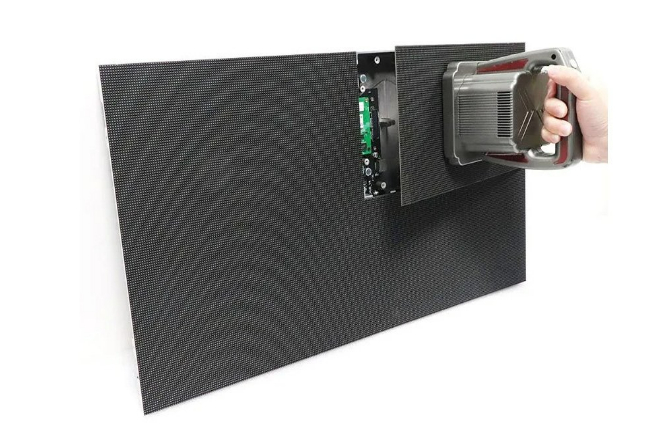
1). Front maintenance
Front maintenance refers to maintenance and repair work by maintenance personnel through the front (display surface) of the LED screen.
This maintenance method usually involves magnetic adsorption and fixation between magnetic elements and the LED screen cabinet so that maintenance personnel can directly contact the cabinet surface and remove the module structure of the LED screen from its cabinet for maintenance.
특징:
- Space saving:
The front maintenance method does not require a reserved maintenance channel, and the overall structure of the display can be made thin and light, saving space. For indoor inlaid or wall-mounted structures, saving space is crucial.
Front maintenance can greatly reduce the overall thickness of the LED display structure, making it integrated with the surrounding architectural environment.
- 편리한 유지 관리:
Front maintenance supports independent front maintenance without the need to disassemble wires, making disassembly simpler and more convenient. In the event of a single point failure, only one person is required to disassemble and maintain a single LED or pixel, with high maintenance efficiency and low cost.
In addition, when performing front maintenance operations, technicians can directly see the display effect of the screen, which is convenient for timely adjustment of the position and angle of the module, ensuring that the replaced or repaired module can perfectly cooperate with other normal modules to achieve the best display effect.
- 높은 기술 요구 사항:
Since maintenance needs to be performed on the front, high requirements are placed on the heat dissipation performance of the box to avoid local failures of the display.
At the same time, the front maintenance method also requires the design of the module structure to facilitate disassembly and installation from the front.
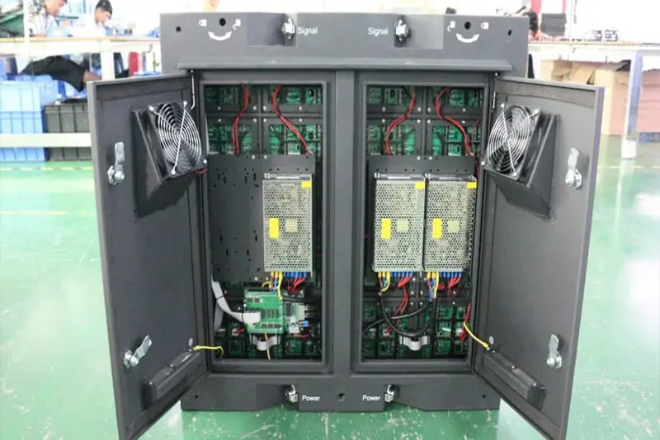
2). Rear maintenance
Rear maintenance refers to maintenance and inspection work by maintenance personnel through the back of the LED display. This maintenance method requires the design of a maintenance channel so that maintenance personnel can enter the back of the screen for operation.
특징:
- Requires to reserve rear space:
The rear maintenance method requires sufficient maintenance channel space to allow maintenance personnel to enter the back of the screen for operation. This may be a challenge for environments with limited installation space.
- Maintenance may affect use:
Since rear maintenance requires entering the back of the screen for operation, the display may need to be turned off or at least partially turned off during maintenance, which may affect the user experience.
- 높은 기술 요구 사항:
Rear maintenance requires the design of a maintenance channel, the overall technical requirements are high, and the installation and disassembly are cumbersome, time-consuming, and labor-intensive.
However, the rear maintenance method allows technicians to easily access components located on the back of the screen, such as the power supply, control system, and signal transmission lines, and conduct a comprehensive inspection and repair of the entire screen’s operating system.
2. Reasons for choosing front maintenance for indoor LED display screens
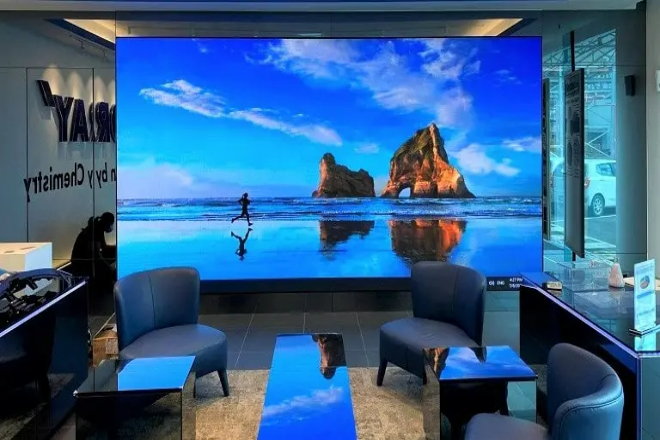
1). High space utilization efficiency
One of the biggest features of the front maintenance method is its efficient space utilization. Since front maintenance does not require a maintenance channel to be reserved behind the display screen, the overall structure of the display screen can be made thinner and lighter, thereby maximizing the use of indoor space.
In contrast, the rear maintenance method requires the design of a special maintenance channel, which not only increases the overall space occupation but also limits the installation location and method of the display screen.
Taking the indoor conference display as an example, the space of the conference room is often limited, and other equipment, such as tables, chairs, and projectors, needs to be arranged. If the rear maintenance method is adopted, sufficient maintenance channel space needs to be reserved, which may occupy the already tight space resources.
If the front maintenance method is adopted, the display screen can be installed close to the wall without reserving a maintenance channel, thus saving valuable space for other equipment.
2). Convenient maintenance operation
The front maintenance method allows maintenance personnel to operate directly from the front of the display screen without moving the display screen or entering behind it. This greatly simplifies the maintenance process and improves maintenance efficiency.
For example, when a single point failure occurs on the display screen, the maintenance personnel only need to unscrew the faulty module from the front to replace or repair it without disassembling the entire display screen or entering behind it.
The front maintenance method not only saves maintenance time but also reduces maintenance costs. Since there is no need to move the display screen or enter behind it, no additional maintenance equipment and labor costs are required.
At the same time, since maintenance operations are convenient, faults can be located and solved faster, improving maintenance efficiency.
3). Aesthetics and integrated design
The front maintenance method allows the display screen to be installed close to the wall without reserving a maintenance channel so that it can be better integrated with the interior decoration style.
This is especially important for indoor environments that pursue aesthetics and integrated design. In contrast, the rear maintenance method requires the design of a special maintenance channel, which may destroy the integrity of the interior decoration.
The rear maintenance method may cause the display screen to be inconsistent with the interior decoration style because it requires the reservation of a maintenance channel. Especially in some places with high requirements for aesthetics, such as high-end hotels and shopping malls, the rear maintenance method may appear abrupt and inconsistent.
4). Safety considerations
The front maintenance method allows maintenance personnel to operate directly from the front of the display screen without entering the back. This avoids the risk of maintenance personnel entering dangerous areas and improves the safety of the maintenance process.
Especially in some high-altitude or narrow installation environments, the rear maintenance method may bring greater safety hazards.
The rear maintenance method requires maintenance personnel to enter the back of the display screen for operation, which may bring some safety hazards.
For example, in a high-altitude installation environment, maintenance personnel may need to climb or hang on the maintenance channel to operate, which may increase the risk of falling or injury.
3. Cases and effects of front maintenance in practical applications
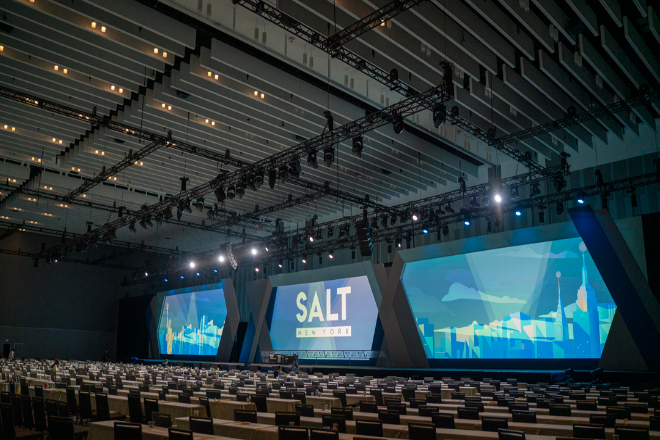
1). New York Javits Convention Center
As a world-renowned conference and exhibition venue, the New York Javits Convention Center has extremely high requirements for indoor LED screens.
In order to improve the display effect of conferences and exhibitions, the conference center decided to introduce a high-resolution, large-size indoor LED screen.
Considering the limited space of the conference center and the need for frequent maintenance and content updates, they chose an LED screen with a front maintenance design.
During the implementation process, the technicians customized an LED screen that fits perfectly with the wall according to the layout and decoration style of the conference center. This screen uses advanced magnetic fixing technology, making the removal and installation of the module extremely simple and fast.
Maintenance personnel do not need to enter the back of the screen but can easily complete the replacement and maintenance of the module from the front. At the same time, the screen is also equipped with an intelligent monitoring system that can monitor the operating status of the screen in real-time to ensure the smooth progress of the meeting.
- Maintenance effect:
Since the adoption of the LED screen with front maintenance design, the maintenance efficiency of the New York Javits Convention Center has been significantly improved. Maintenance personnel can quickly complete maintenance work between meetings without moving any large equipment, greatly reducing maintenance costs and time.
In addition, the screen’s intelligent monitoring system effectively prevents potential failures, improves the reliability and stability of the screen, and provides a more outstanding display effect for conferences and exhibitions.
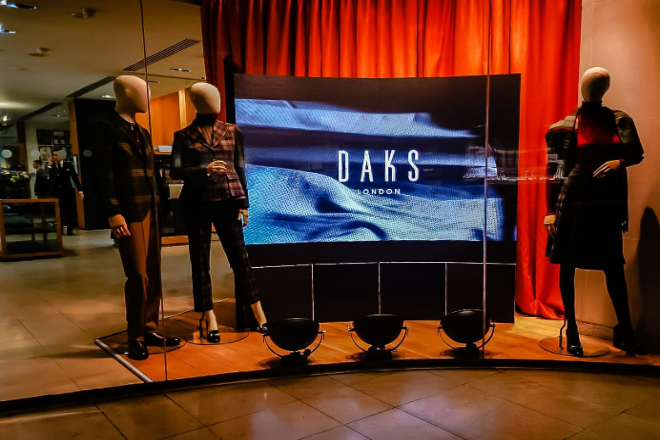
2). Harrods Department Store in London
As a famous high-end department store in the UK, Harrods Department Store in London has been committed to improving customers’ shopping experience.
In order to attract more customers and enhance the brand image of the mall, the mall decided to install a huge LED screen in the atrium to display advertisements and promotional information.
Considering the large flow of people in the mall and the need to frequently update the playback content, they chose a front-maintenance LED screen.
During the implementation process, the technicians customized an LED screen that complements the mall environment according to the mall’s decorative style. The screen adopts a high-strength, lightweight box design combined with an advanced locking mechanism, making the disassembly and installation of the module extremely simple and quick.
At the same time, the screen is also equipped with a remote control system, and the mall managers can remotely control the screen through a computer or mobile phone to achieve real-time updates and playback of content.
- Maintenance effect:
Since the adoption of the front-maintenance designed LED screen, the advertising efficiency of Harrods Department Store in London has been significantly improved. Maintenance personnel can quickly replace and update advertising materials during the mall’s business hours without having to go behind the screen or move any equipment.
This not only reduces maintenance costs and time but also ensures the timeliness and effectiveness of advertising. In addition, the high strength and lightweight design of the screen make its installation more stable and reliable, effectively avoiding screen damage caused by collisions with people or other unexpected factors.
3). Inspiration of these cases on the maintenance methods of indoor LED screens
- Improve space utilization:
The front maintenance design eliminates the need to reserve maintenance channels for LED screens, thereby greatly improving the utilization of indoor space. This is particularly important for places with limited space, such as the Javits Convention Center in New York.
- Simplify maintenance process:
The front maintenance design allows maintenance personnel to quickly complete maintenance work without moving large equipment or entering behind the screen. This not only reduces maintenance costs and time but also improves maintenance efficiency.
For places with high traffic volume, such as Harrods Department Store in London, this helps ensure timely updates and broadcasts of advertisements.
- Improve safety and aesthetics:
The front maintenance design avoids screen damage caused by collisions with people or other unexpected factors while ensuring the aesthetics of the screen and its coordination with the surrounding environment. This is essential to enhance the brand image of shopping malls or conference centers.
결론
In summary, it is not accidental that indoor LED display screens choose front maintenance, but it is determined by its many advantages.
Front maintenance not only improves the efficiency of space utilization and makes maintenance operations more convenient but also maintains aesthetics and integrated design, enhances safety, and has significant advantages in technology development and cost factors.
Through the analysis of actual cases, we can see the wide application and good results of front maintenance in the maintenance of indoor LED display screens.
마지막으로 LED 디스플레이 화면에 대해 더 알고 싶다면, 우리에게 연락해주세요.
